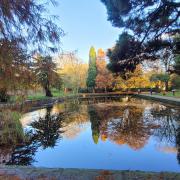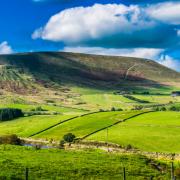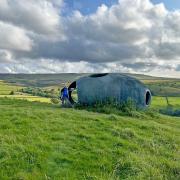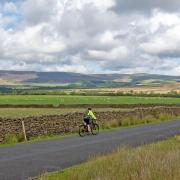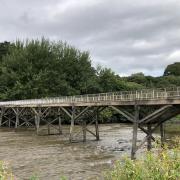Keith Carter stays on the straight and narrow on a riverside route among the fields at Hesketh Bank

Everything about Hesketh Bank is straight. Apart from the right-angles. It's as though the landowners got together with a ruler and divided the area up into blocks of land, sharing them out between them. Public footpaths go along straight lines, most of the time along raised banks between fields. These are designed to alleviate flooding when the River Douglas bursts its banks. The tidal Douglas, or Asland as it was once known, rises on Winter Hill where our walk in the June edition took us, and flows into the Ribble. This made it possible to create the Millennium Ribble Link which opened in 2002 at a cost of £6m, connecting the Lancaster Canal and the Leeds Liverpool, to the delight of narrow boat enthusiasts. Navigating this route involves grouping the boats into convoys in one direction at a time, depending on suitable tide conditions. I've never done the trip although it's on my bucket list.
In choosing the Hesketh Bank area for a walk you are going to have to accept the straight lines. This is market garden country with glass houses everywhere. It's dead flat. You won't be faced with climbing hills, that's for sure. This suited my companion Jim who was putting new boots through their paces when we researched the walk. Fitting Jim with boots tested the nice staff at Whalley Wet and Wild to the limit since he has one foot size 10½ and the other size 11. Short of buying two pairs, this has to be accommodated by the use of inner padding and by stretching the leather over a heated former. I rather fear our walks in future will involve plenty of comments about how the boots are wearing in.
There's no obvious place to park in the village so we left the car at the kerb in Becconsall Lane, one of those quiet neighbourhoods where they have signs saying they don't answer the door to cold callers. The lane narrows towards the far end and leads to Becconsall Old Church set amid a cluster of imposing gravestones. Built in 1764 in brick with arched windows and a small bellcote, the church survived a World War Two bombing attack with only slight damage to some of the headstones. You can still see some with chips out of them caused by shrapnel.
The lane ends at a boat-yard, one of those places which seem to function in spite of an air of neglect. This is no marina, more a muddy creek with boats up on blocks, rotting hulls, half-built or dismasted craft on which work has been long abandoned, yet work seems to be conducted here and people employed. To find the footpath, go through the gate into the boat-yard and turn left, keeping the buildings on your right to where a new five-barred gate has been installed.

Go through it and take the banked grassy path that heads away with the river on the right wending its sluggish way between muddy banks. We walk either on the top of the bank or at the lower level on the marsh grass, a broad swathe between the bank and the river which is grazed by cattle.
These marshes are frequented by wildfowl between September and March, mainly widgeon and pinkfooted geese but on our visit we saw only shellduck and oyster catchers, birds that share similar colouring, black and white with a sharp flash of orange. The terrain is uniform and unchanging and if you are feeling active you can follow the bank to the confluence of the Douglas with the Ribble. You're likely to see the Eurofighter undergoing trials from the British Aerospace site at Warton sufficiently far away not to shatter the prevailing calm.
For our walk we left the embankment at the third inlet and head inland on a footpath indicated by a sign, walking beside a watercourse called Carr Heys which brings us to a dead straight lane called Guide Road where we turn left. This way passes some large burrows, evidence of either multiple rabbit activity or badgers although I can't see badger setts being left untouched so close to civilisation. I don't mind badgers but have an ongoing battle with rabbits that have dug up my lawn and made a permanent enemy of me.
From here it is about a mile back to Becconsall Lane along Guide Road, turning left at the top then right to follow Station Road back to Hesketh Bank. A youth waiting at the bus stop asked Jim to go to the shop and buy cigarettes for him. Jim read him the Riot Act, railing at him for smoking and telling him how much he could save by giving up. There's nobody worse than a reformed smoker, is there?
Hesketh Bank has one attraction that adds to its appeal, namely the West Lancashire Light Railway. While not a railway enthusiast myself, or 'whistle-basher' as I think they're known, I can see the interest that a trip on a restored engine might bring. The WLLR wasn't running on the day of our walk but they have a full programme of events through the summer.
While you're there
Hesketh Out Marsh is an RSPB site near Hesketh Bank which opened five years ago is a great place to see pink-footed geese, wigeons, teals as well as flocks of golden plovers, lapwings and black-tailed godwits. In spring the marshes are alive with the sight and sound of displaying waders, including avocets and lapwings.
Hesketh Out Marsh is open from 8am to 6pm or dusk if it is earlier. Entry is free. For more information go to www.rspb.org.uk/heskethoutmarsh.
The West Lancashire Light Railway is a two foot gauge passenger carrying railway which features a number of interesting locomotives and other railway equipment brought together from across Britain.
Trains run on Sundays and Bank Holidays until the end of October and the Summer Gala Weekend will be held on August 9-10. For more information call 01772 815881 or go to www.wllr.net.
Compass points
Area of walk: Hesketh Bank
Start from: Becconsall Lane
Distance of walk: 3 miles
Time taken: 2 hours
Map: OS Explorer286 Blackpool and Preston
Refreshments: None on walk
Not suitable for wheelchair or pushchair users.
















